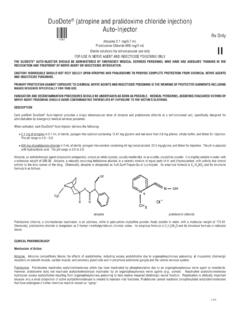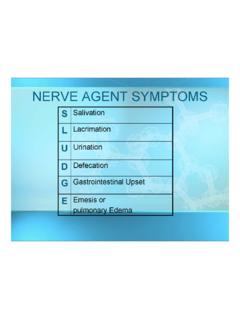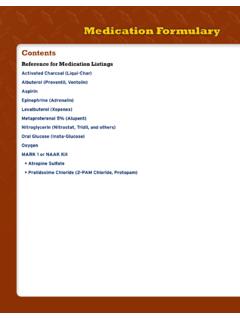Transcription of “ATNAA” (ANTIDOTE TREATMENT – NERVE AGENT, AUTO …
1 ATNAA (ANTIDOTE TREATMENT NERVE AGENT, auto -INJECTOR) ATROPINE INJECTION, mL PRALIDOXIME CHLORIDE INJECTION, 600 mg/2 mL FOR USE IN NERVE AGENT POISONING ONLY STERILE SOLUTIONS FOR INTRAMUSCULAR USE ONLY DESCRIPTION The Antidote TREATMENT - NERVE Agent, auto -Injector (ATNAA) provides Atropine Injection and Pralidoxime Chloride Injection in separate chambers as sterile, pyrogen-free solutions for intramuscular injection. The ATNAA is a specially designed unit for automatic self- or buddy-administration by military personnel. When activated, the ATNAA sequentially administers atropine and pralidoxime chloride through a single needle. The recommended procedure (see DOSAGE AND ADMINISTRATION) is to inject the contents of the auto -injector into the muscles of an outer thigh or into the buttocks.
2 When activated, each ATNAA dispenses: mg atropine in mL of a sterile, pyrogen-free solution containing mg glycerin and not more than mg phenol, citrate buffer, and Water for Injection. The pH range is And 600 mg of pralidoxime chloride in 2 mL of a sterile, pyrogen-free solution containing 40 mg benzyl alcohol, mg glycine, and Water for Injection. The pH is adjusted with hydrochloric acid. The pH range is After an ATNAA has been activated, the empty container should be disposed of properly (see DOSAGE AND ADMINISTRATION). It cannot be refilled, nor can the protruding needle be retracted. Atropine, an anticholinergic agent (muscarinic antagonist), occurs as white crystals, usually needle-like, or as a white, crystalline powder.
3 It is slightly soluble in water, soluble in glycerin and ether, and freely soluble in alcohol and chloroform with a molecular weight of Atropine, a naturally occurring belladonna alkaloid, is a racemic mixture of equal parts of d- and l- hyoscyamine, whose activity is due almost entirely to the levo isomer of the drug. Chemically, atropine is designated as 1 H,5 H-Tropan-3 -ol (+)-tropate. Its empirical formula is C17H23NO3 and its structural formula is: Pralidoxime chloride, a cholinesterase reactivator, is an odorless, white to pale-yellow crystalline powder, freely soluble in water, with a molecular weight of Chemically, pralidoxime chloride is designated as 2-formyl-1-methylpyridinium chloride oxime. Its empirical formula is C7H9 CIN2O and its structural formula is: The specific activity of the drug resides in the 2-formyl-1-methylpyridinium ion and is independent of the particular salt employed.
4 The chloride salt is preferred because of physiologic compatibility, excellent water solubility at all temperatures, and high potency per gram, due to its low molecular weight. CLINICAL PHARMACOLOGY Mechanism of Action: Atropine Atropine is commonly classified as an anticholinergic or antiparasympathetic (parasympatholytic) drug. More precisely, however, it is termed an antimuscarinic agent since it antagonizes the muscarine-like actions of acetylcholine and other choline esters. Atropine inhibits the muscarinic actions of acetylcholine on structures innervated by postganglionic cholinergic nerves, and on smooth muscles which respond to endogenous acetylcholine but are not so innervated. As with other antimuscarinic agents, the major action of atropine is a competitive or surmountable antagonism which can be overcome by increasing the concentration of acetylcholine at receptor sites of the effector organ ( , by using anticholinesterase agents which inhibit the enzymatic destruction of acetylcholine).
5 The receptors antagonized by atropine are the peripheral structures that are stimulated or inhibited by muscarine, ( , exocrine glands and smooth and cardiac muscle). Responses to postganglionic cholinergic NERVE stimulation may also be inhibited by atropine but this occurs less readily than with responses to injected (exogenous) choline esters. Pralidoxime Chloride The principal action of pralidoxime is to reactivate cholinesterase (mainly outside the central nervous system) which has been inactivated by phosphorylation due to an organophosphorous NERVE agent or related compound, although pralidoxime does not reactivate cholinesterase inactivated by all organophosphate NERVE agents ( soman). The destruction of accumulated acetylcholine can then proceed and neuromuscular junctions will again function normally.
6 Pralidoxime also slows the process of aging of phosphorylated cholinesterase to a non-reactivatable form and detoxifies certain organophosphates by direct chemical reaction. Pharmacodynamics: Atropine Atropine reduces secretions in the mouth and respiratory passages, relieves the constriction and spasm of the respiratory passages, and may reduce the paralysis of respiration which results from actions of the toxic agent on the central nervous system. Atropine-induced parasympathetic inhibition may be preceded by a transient phase of stimulation, especially on the heart where small doses first slow the rate before characteristic tachycardia develops due to paralysis of vagal control. Although mild vagal excitation occurs, the increased respiratory rate and occasionally increased depth of respiration produced by atropine are more probably the result of bronchiolar dilatation.
7 Accordingly, atropine is an unreliable respiratory stimulant and large or repeated doses may depress respiration. Adequate doses of atropine abolish various types of reflex vagal cardiac slowing or asystole. The drug also prevents or abolishes bradycardia or asystole produced by injection of choline esters, anticholinesterase agents or other parasympathomimetic drugs, and cardiac arrest produced by stimulation of the vagus. Atropine may also lessen the degree of partial heart block when vagal activity is an etiologic factor. In some patients with complete heart block, the idioventricular rate may be accelerated by atropine; in others, the rate is stabilized. Occasionally, a large dose may cause atrioventricular (A-V) block and nodal rhythm. Atropine in clinical doses counteracts the peripheral dilatation and abrupt decrease in blood pressure produced by choline esters.
8 However, when given by itself, atropine does not exert a striking or uniform effect on blood vessels or blood pressure. Systemic doses slightly raise systolic and lower diastolic pressures and can produce significant postural hypotension. Such doses also slightly increase cardiac output and decrease central venous pressure. Occasionally, therapeutic doses dilate cutaneous blood vessels, particularly in the blush area (atropine flush), and may cause atropine fever due to suppression of sweat gland activity in infants and small children. Pralidoxime Chloride Pralidoxime chloride has its most critical effect in relieving paralysis of the muscles of respiration. Because pralidoxime is less effective in relieving depression of the respiratory center, atropine is always required concomitantly to block the effect of accumulated acetylcholine at this site.
9 Pralidoxime relieves muscarinic signs and symptoms, salivation, bronchospasm, etc., but this action is relatively unimportant since atropine is adequate for this purpose. Published reports have established the safety and efficacy of atropine and pralidoxime chloride used separately, as well as the safety and increased efficacy of atropine and pralidoxime chloride when administered concomitantly in the TREATMENT of NERVE agent poisoning in humans3. Pharmacokinetics: Atropine Atropine is rapidly and well absorbed after intramuscular administration. Atropine disappears rapidly from the blood and is distributed throughout the various body tissues and fluids. Much of the drug is destroyed by enzymatic hydrolysis, particularly in the liver; from 13 to 50% is excreted unchanged in the urine.
10 Traces are found in various secretions, including milk. Atropine readily crosses the placental barrier and enters the fetal circulation. The Cmax, Tmax, and T of atropine following mg atropine given intramuscularly by multi-chambered delivery system was 13 + 3 ng/mL, 31 + 30 minutes, and + hours, respectively. The protein binding of atropine is 14 to 22% in plasma. There are gender differences in the pharmacokinetics of atropine. The AUC(0-inf) and Cmax were 15% higher in females than males. The half-life of atropine is slightly shorter (approximately 20 minutes) in females than males. Pralidoxime Chloride Pralidoxime is distributed throughout the extracellular water; it is not bound to plasma protein. The drug is rapidly excreted in the urine partly unchanged, and partly as a metabolite produced by the liver.






